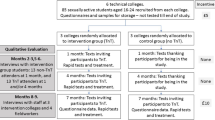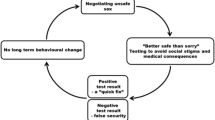Abstract
Objectives
A self-test screening program for genital C. trachomatis infection in female students attending high school in rural Nova Scotia was introduced. The objectives of this pilot study were to determine the extent of uptake, reasons for being/not being screened, and whether students at risk would be more likely to be screened.
Methods
The screening program was carried out between September 2005 and May 2006. Test kits were accessed through the school’s health centre without first seeing the school nurse for counselling. Tests were processed non-nominally at the laboratory. A cross-sectional survey was offered to all students in the school to assess factors related to participation or non-participation. Univariate analysis was carried out for young women’s sexual activity and risk taking, reasons for being participants or non-participants, risk behaviours, and knowledge about chlamydia.
Results
One hundred and sixty-three women (58%) had had vaginal intercourse at least once. Twenty-four of these used the self-test kit. Though 83% of those not using the self-test knew that females with chlamydia are very often asymptomatic, 54% indicated lack of symptoms as a reason for not doing so. Many (49%) gave low probability of infection as a reason for not using the kit, but high-risk sexual activity was frequent in these young women.
Discussion
Uptake of self-testing for C. trachomatis was lower than anticipated. This may be due to lack of counselling meant to encourage testing to overcome a dissonance of knowledge and behaviour. Self-testing should be further explored to better understand its potential to increase chlamydia screening among Canadian adolescents.
Résumé
Objectifs
Un programme de dépistage des infections génitales à Chlamydia trachomatis au moyen d’une trousse d’auto-examen a été lancé pour les adolescentes fréquentant l’école secondaire dans es zones rurales de la Nouvelle-Ecosse. Les objectifs de notre étude pilote étaient de déterminer le niveau de participation au programme, les raisons pour lesquelles les élèves se soumettaient ou non au dépistage, et si les élèves à risque étaient ou non plus susceptibles d’utiliser la trousse.
Méthode
Le programme de dépistage a été administré entre septembre 2005 et mai 2006. Des trousses d’examen étaient disponibles au centre sanitaire de l’école, mais il n’était pas prévu que les élèves reçoivent au préalable les conseils de l’infirmière scolaire. Les trousses ont été analysées anonymement en laboratoire. Un sondage transversal a été proposé à toutes les élèves de l’école pour déterminer les facteurs liés à leur participation ou à leur non-participation. Une analyse univariée a porté sur l’activité sexuelle des jeunes femmes et les risques qu’elles prennent, sur leurs raisons de participer ou non au programme de dépistage, sur leurs comportements à risque et sur eurs connaissances de la chlamydiose.
Résultats
Cent soixante-trois filles (58 %) avaient eu des relations sexuelles avec pénétration vaginale au moins une fois. Vingt-quatre de ces jeunes filles avaient utilisé la trousse d’auto-examen. Même si 83 % des élèves n’ayant pas utilisé la trousse savaient que les femmes qui présentent une chlamydiose sont très souvent asymptomatiques, 54 % ont indiqué qu’elles ne s’étaient pas soumises au dépistage parce qu’elles ne présentaient pas de symptômes. Beaucoup (49 %) ont mentionné la faible probabilité d’infection comme raison de ne pas avoir utilisé la trousse, mais les activités sexuelles à risque élevé étaient fréquentes chez ces jeunes femmes.
Discussion
La participation à l’autodépistage de C. trachomatis a été plus faible que prévu, ce qui pourrait s’expliquer par l’absence de counseling pour surmonter la dissonance entre les connaissances et les comportements et encourager le dépistage. L’auto-examen devrait faire l’objet d’études plus poussées pour mieux comprendre ses possibilités en tant qu’outil de dépistage de la chlamydiose chez les adolescentes canadiennes.
Similar content being viewed by others
References
Dryfoos JG. Adolescents at Risk. New York, NY: Oxford University Press, 1990.
Makinson C. The health consequences of teenage fertility. Fam Plann Perspect 1985;17:132–38.
Health Canada. Sexually Transmitted Infections (STI) Surveillance Report 2002: Canada. Ottawa, June, 2004. Available online at: https://doi.org/www.hc-sc.gc.ca/pphb-dgspsp/std-mts/stddata_pre06_04/index.html (Accessed July 16, 2004).
Donovan P. Testing positive: Sexually Transmitted Disease and the Public Response. New York: The Alan Guttmacher Institute, 1993.
Zelnik M, Shah FK. First intercourse among young Americans. Fam Plann Perspect 1983;15:64–70.
Royal Commission on New Reproductive Technologies. Proceed with Care: Final Report of the Royal Commission on New Reproductive Technologies. Ottawa: Minister of Government Services Canada, 1993.
Davies HD, Wang EL. The Canadian Task Force on the Periodic Health Examination. Periodic health examination, 1996 update: 2. Screening for chlamydial infections. CMAJ 1996;154:1631–44.
Boag F, Kelly F. Screening for Chlamydia trachomatis. BMJ 1998;316:1474–80.
CDC Sexually Transmitted Diseases Treatment Guidelines 2006. Available online at: https://doi.org/www.cdc.gov/std/treatment/ (Accessed December 13, 2006).
Small ML, Maker LS, Allensworth DD, Farquhar BK, Kann L, Pateman BC. School health services. J Sch Health 1995;65:319–26.
Cohen DA, Nsuami M, Martin DH, Farley TA. Repeated school-based screening for sexually transmitted diseases: A feasible strategy for reaching adolescents. Pediatrics 1999;104:1281–85.
Asbel LE, Newbern C, Salmon M, Spain CV, Goldberg M. School-based screening for Chlamydia trachomatis and Neisseria gonorrhoeae among Philadelphia public high school students. Sex Transm Dis 2006;33:614–20.
Wisenfeld HC, Lowry DL, Heine RP, Krohn MA, Bittner H, Kellinger K, et al. Self-collection of vaginal swabs for the detection of chlamydia, gonorrhea and trichomoniasis: Opportunity to encourage sexually transmitted diseases testing among adolescents. Sex Transm Infect 2001;28:321–25.
Corwin P, Abel G, Wells E, Coughlan E, Bagshaw S, Sutherland M, et al. Chlamydia trachomatis prevalence and sexual behaviour in Christchurch high school students. N Z Med J 2002;115:1–8.
Debattista J, Martin P, Jamieson J, Crane K, Dolton I, Russell-Hall S, et al. Detection of Chlamydia trachomatis in an Australian high school student population. Sex Transm Infect 2002;78:194–97.
Schacter J, McCormack WM, Chernesky MA, Martin DH, Van Der Po B, Rice PA, et al. Vaginal swabs are appropriate specimens for diagnosis of genital tract infection with Chlamydia trachomatis. Clin Microbiol 2003;41:3784–89.
Garrow SC, Smith DW, Harnett GB. The diagnosis of chlamydia, gonorrhoea, and trichomonas infections by self obtained low vaginal swabs in remote northern Australian medical practice. Sex Transm Infect 2003;78:278–81.
Statistics Canada. Canadian Community Profiles. Available online at: https://doi.org/www12.statcan.ca/english/profil01/CP01/ (Accessed November 28, 2006).
Richard M. The Evaluation Framework of the Teen Health Centre’s 2003–2004 Operations at Amherst Regional High School. Amherst Association for Healthy Adolescent Sexuality, 2004.
Akinbami LJ, Gandhi H, Cheng TL. Availability of adolescent health services and confidentiality in primary care practices. Pediatrics 2003;111:394–401.
Ford CA, Jaccard J, Millstein SG, Bardsley PE, Miller WC. Perceived risk of chlamydial and gonococcal infection among sexually experienced adults in the United States. Perspect Sex Reprod Health 2004;26:258–64.
Cancer Care Nova Scotia. The Nova Scotia Gynaecological Screening Program. Available online at: https://doi.org/www.cancercare.ns.ca/media/documents/ (Accessed December 5, 2006).
Khan A, Hussain R, Plummer D, Minichiello V. Willingness to offer Chlamydia testing in general practice in New South Wales. Aust N Z J Public Health 2006;30:226–30.
McClure JB, Scholes D, Grothaus L, Fishman P, Reid R, Lindenbaum J, et al. Chlamydia screening in at-risk adolescent females: An evaluation of screening practices and modifiable screening correlates. J Adolesc Health 2006;38:726–33.
Moses S, Elliott L. Sexually transmitted diseases in Manitoba: Evaluation of physician treatment practices, STD drug utilization, and compliance with screening and treatment guidelines. Sex Transm Dis 2002;29:840–46.
Author information
Authors and Affiliations
Corresponding author
Additional information
Source of funding: The Capital District Health Authority Research Fund
Rights and permissions
About this article
Cite this article
Langille, D.B., Proudfoot, K., Rigby, J. et al. A Pilot Project for Chlamydia Screening in Adolescent Females Using Self-testing. Can J Public Health 99, 117–120 (2008). https://doi.org/10.1007/BF03405457
Received:
Accepted:
Published:
Issue Date:
DOI: https://doi.org/10.1007/BF03405457




